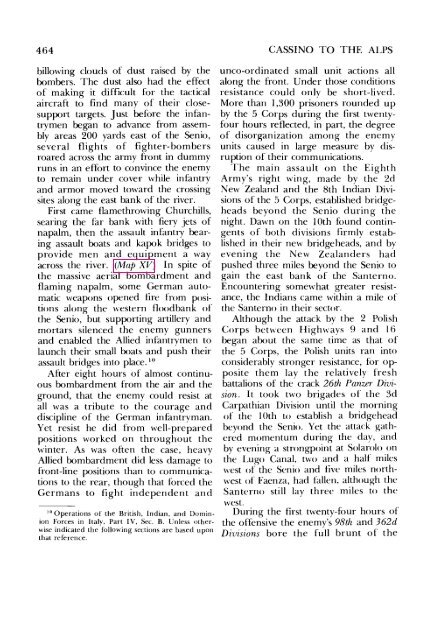Cassino to the Alps - US Army Center Of Military History
Cassino to the Alps - US Army Center Of Military History
Cassino to the Alps - US Army Center Of Military History
You also want an ePaper? Increase the reach of your titles
YUMPU automatically turns print PDFs into web optimized ePapers that Google loves.
464<br />
billowing clouds of dust raised by <strong>the</strong><br />
bombers. The dust also had <strong>the</strong> effect<br />
of making it difficult for <strong>the</strong> tactical<br />
aircraft <strong>to</strong> find many of <strong>the</strong>ir closesupport<br />
targets. Just before <strong>the</strong> infantrymen<br />
began <strong>to</strong> advance from assembly<br />
areas 200 yards east of <strong>the</strong> Senio,<br />
several flights of fighter-bombers<br />
roared across <strong>the</strong> army front in dummy<br />
runs in an effort <strong>to</strong> convince <strong>the</strong> enemy<br />
<strong>to</strong> remain under cover while infantry<br />
and armor moved <strong>to</strong>ward <strong>the</strong> crossing<br />
sites along <strong>the</strong> east bank of <strong>the</strong> river.<br />
First came f1amethrowing Churchills,<br />
searing <strong>the</strong> far bank with fiery jets of<br />
napalm, <strong>the</strong>n <strong>the</strong> assault infantry bearing<br />
assault boats and kapok bridges <strong>to</strong><br />
provide men and equipment a way<br />
across <strong>the</strong> river. (Map XV) In spite of<br />
<strong>the</strong> massive aerial bombardment and<br />
flaming napalm, some German au<strong>to</strong>matic<br />
weapons opened fire from positions<br />
along <strong>the</strong> western flood bank of<br />
<strong>the</strong> Senio, but supporting artillery and<br />
mortars silenced <strong>the</strong> enemy gunners<br />
and enabled <strong>the</strong> Allied infantrymen <strong>to</strong><br />
launch <strong>the</strong>ir small boats and push <strong>the</strong>ir<br />
assault bridges in<strong>to</strong> place. 10<br />
After eight hours of almost continuous<br />
bombardment from <strong>the</strong> air and <strong>the</strong><br />
ground, that <strong>the</strong> enemy could resist at<br />
all was a tribute <strong>to</strong> <strong>the</strong> courage and<br />
discipline of <strong>the</strong> German infantryman.<br />
Yet resist he did from well-prepared<br />
positions worked on throughout <strong>the</strong><br />
winter. As was often <strong>the</strong> case, heavy<br />
Allied bombardment did less damage <strong>to</strong><br />
front-line positions than <strong>to</strong> communications<br />
<strong>to</strong> <strong>the</strong> rear, though that forced <strong>the</strong><br />
Germans <strong>to</strong> fight independent and<br />
10 Operations of <strong>the</strong> British. Indian, and Dominion<br />
Forces in Italy. Part IV, Sec. B. Unless o<strong>the</strong>rwise<br />
indicated <strong>the</strong> following sections are based upon<br />
that reference.<br />
CASSINO TO THE ALPS<br />
unco-ordinated small unit actions all<br />
along <strong>the</strong> front. Under those conditions<br />
resistance could only be short-lived.<br />
More than 1,300 prisoners rounded up<br />
by <strong>the</strong> 5 Corps during <strong>the</strong> first twentyfour<br />
hours reflected, in part, <strong>the</strong> degree<br />
of disorganization among <strong>the</strong> enemy<br />
units caused in large measure by disruption<br />
of <strong>the</strong>ir communications.<br />
The main assault on <strong>the</strong> Eighth<br />
<strong>Army</strong>'s right wing, made by <strong>the</strong> 2d<br />
New Zealand and <strong>the</strong> 8th Indian Divisions<br />
of <strong>the</strong> 5 Corps, established bridgeheads<br />
beyond <strong>the</strong> Senio during <strong>the</strong><br />
night. Dawn on <strong>the</strong> 10th found contingents<br />
of both divisions firmly established<br />
in <strong>the</strong>ir new bridgeheads, and by<br />
evening <strong>the</strong> New Zealanders had<br />
pushed three miles beyond <strong>the</strong> Senio <strong>to</strong><br />
gain <strong>the</strong> east bank of <strong>the</strong> Santerno.<br />
Encountering somewhat greater resistance,<br />
<strong>the</strong> Indians came within a mile of<br />
<strong>the</strong> Santerno in <strong>the</strong>ir sec<strong>to</strong>r.<br />
Although <strong>the</strong> attack by <strong>the</strong> 2 Polish<br />
Corps between Highways 9 and 16<br />
began about <strong>the</strong> same time as that of<br />
<strong>the</strong> 5 Corps, <strong>the</strong> Polish units ran in<strong>to</strong><br />
considerably stronger resistance, for opposite<br />
<strong>the</strong>m lay <strong>the</strong> relatively fresh<br />
battalions of <strong>the</strong> crack 26th Panzer Division.<br />
It <strong>to</strong>ok two brigades of <strong>the</strong> 3d<br />
Carpathian Division until <strong>the</strong> morning<br />
of <strong>the</strong> 10th <strong>to</strong> establish a bridgehead<br />
beyond <strong>the</strong> Senio. Yet <strong>the</strong> attack ga<strong>the</strong>red<br />
momentum during <strong>the</strong> day, and<br />
by evening a strongpoint at Solarolo on<br />
<strong>the</strong> Lugo Canal, two and a half miles<br />
west of <strong>the</strong> Senio and five miles northwest<br />
of Faenza, had fallen, although <strong>the</strong><br />
Santerno still lay three miles <strong>to</strong> <strong>the</strong><br />
west.<br />
During <strong>the</strong> first twenty-four hours of<br />
<strong>the</strong> offensive <strong>the</strong> enemy's 98th and 362d<br />
Divisions bore <strong>the</strong> full brunt of <strong>the</strong>
















